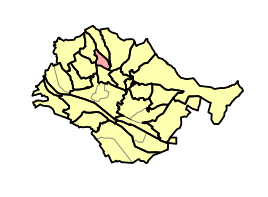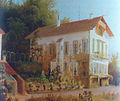Serach
|
Serach
City of Esslingen am Neckar
Coordinates: 48 ° 45 ′ 29 " N , 9 ° 18 ′ 37" E
|
|
|---|---|
| Residents : | 1663 (Jun 30, 2016) |
| Postal code : | 73732 |
| Area code : | 0711 |
|
Location of Serach in Esslingen am Neckar
|
|
Serach is a district of Esslingen am Neckar . It is located in the north of the city and consists mainly of residential developments, with the historical, once agricultural core today being on the northern edge of the district and the more recent development from the 20th century being more in the south. Serach borders the districts of Hohenkreuz , Wäldenbronn , Obertal , Sulzgries and Krummenacker .
history
The place or field name "Seherach" is first documented by a source from 1257. The name is probably derived from the Middle High German word saher, which designates reed or sedge. The Salem Monastery owned vineyards in this area in 1327; Serach was mentioned in 1349 as a settlement with at least two estates. Also in the following decades Serach should have had only a few inhabitants; two to three taxpayers are recorded for Serach in the second half of the 14th century. There were probably six medieval buildings in the Serach area, but only one wine press is definitely documented, which was mentioned in 1441, but must have disappeared soon afterwards. In its place was a tree garden in 1463. Nine residents are recorded for 1659; the goods book from 1722 names nine dwellings, two barns and a wine press. The High Cross Castle should have become the center of a settlement core; however, the Hohenkreuz district of the same name did not develop until much later. For 1773/1774, 15 dwellings, some barns and a wine press are documented by Kandler. According to Johann Jacob Keller's description of the imperial city of Esslingen and its area , only one other house was built in Serach by the end of the 18th century. In 1825 there were 20 houses in Serach, in 1859 there were 24 and in 1876 33, not counting the building complex around Hohenkreuz Castle. In the 19th century there was a structural consolidation around Hohenkreuzweg and Seracher Straße, which lead up the slope in front of and behind Hohenkreuz Castle. Likewise, more intensive construction was carried out on today's Schlößlesweg; However, the Serach Castle was only included in Serach in the 20th century.
Around the end of the 19th century, the Serach population structure changed. Up to now it was inhabited almost exclusively by wine growers, but now it was also inhabited by service providers, factory workers and craftsmen. In 1908, about 250 people lived in Serach, which at that time still belonged to Hohenkreuz. In 1912/13 the city of Esslingen bought the Hohenkreuz Castle Estate in order to build the castle barracks . A town center with numerous shops and service providers developed around this. From 1930, the area around Hohenkreuzweg below Barbarossastraße was no longer included in Serach. This resulted in a long period of stagnation for Zerah. Mainly in the 1970s, the residential area Bärenwiesen with many multi-storey apartment blocks was built between Barbarossastraße and Langer Weg, which resulted in a sharp increase in Serach's population. In 1950 441 inhabitants were counted, the number of inhabitants in Serach quadrupled due to the new development. The Hohenkreuz School was built in 1952 and is attended by children from Serach and Hohenkreuz. In 1956/57, Serach and Hohenkreuz, which had grown together through the development of the Bärenwiesen, were united to form a new Protestant parish after they had previously belonged to the parish of St. Bernhardt .
politics
The contact person for the issues of the district for the city administration and the municipal council of Esslingen is the citizens' committee Wäldenbronn, Hohenkreuz, Serach, Obertal . At the district level, the citizens' committee helps shape community life. He is a member of the working group of citizens 'committees , which exists to exchange experiences and coordinate the individual citizens' committees of the city. The basis for the working method and the structure of the citizens' committee and the working group is the status adopted by the working group on February 21, 1991 . An agreement was reached as the basis for the cooperation between the citizens' committee, the municipal council and the administration . This was approved by the working group on July 17, 1990 and approved by the municipal council on December 10, 1990. In June 2000, both the status and the agreement were editorially revised.
In the public citizens 'meeting , which the city of Esslingen held on July 15, 2010 in the gymnasium and assembly hall Hohenkreuz, the citizens' committee of Wäldenbronn, Hohenkreuz, Serach, Obertal was elected for 3 years.
Attractions
In the area of Seracher Straße 161 to 187 there was the largely built-up desert area of Steinigenhardt. The "Länglins House" mentioned in 1330 stood there. Another mention comes from the year 1342. At that time, the Dominican convent Weil sold a gilt from its farm in Steinigenhardt to a citizen in Esslingen. Johann Besemer the Elder Ä. owned a farm in Steinigenhardt and donated monetary interest in 1354 for the chaplains of the Esslingen city church. For 1366 there are two taxpayers in Steinigenhardt, for 1432 a house in Steinigenhardt is documented in the Sirnau monastery register . In 1439 the Esslingen hospital received the house and goods of Wolf Holzapfel. They were located between the property of a Bernhard Fladenesser and a Lienhard Binder. The last known documentary mention of buildings in Steinigenhardt comes from the year 1563; the place apparently fell desolate around the middle of the 16th century.
Serach Castle in Schlößlesweg 39 was built in 1820 as a normal house by the then chief magistrate Karl August Georgii. In 1828 Count Alexander von Württemberg bought the estate and in 1834 had the old palace expanded. In the new salon he received poets such as Justinus Kerner , Hermann Kurz , Nikolaus Lenau , Emma Niendorf , Ludwig Uhland and Gustav Schwab . It is decorated with ceiling paintings by Julius Lettenmayer . In 1853 the Seracher Schlösschen was bought by Prince Felix von Hohenlohe-Öhringen , who expanded it further. Since he had taken on himself financially, he had to sell it to Öhringer Bank in 1864. Today the palace is privately owned. The interiors are not available for viewing.
Felix von Hohenlohe-Öhringen had a so-called guest house built by Christian Friedrich Leins in 1853 , which today has the address Schlößlesweg 41. Another building that was erected under Hohenlohe-Öhringen's direction is the Castellanhaus at Schlößlesweg 45, which was planned by Heinrich Friedrich Haueisen . Both buildings were built in the Swiss house style, but their symmetry still has echoes of classicism . The park, originally laid out in the style of an English garden , was largely replaced by the arboretum laid out in the 20th century .
The arboretum was established as a public park in 1962. In 2000 there were 52 trees in the Arboretum Serach, some of them native trees, 34 introduced trees and 4 horticultural varieties. The imported trees come from the Caucasus, North America, Japan, China, the Himalayas, Serbia, Bosnia, the Pyrenees, South Korea, South America, Austria, the Balkans, southern Spain and the Alps.
Above the three buildings that belonged to the palace complex, there was a climatic spa from 1925, which is now used for other purposes. For a while, it housed the Protestant farmer's school in Württemberg, later an auxiliary hospital for tuberculosis sufferers and then a specialist clinic for lung and bronchial diseases, which was closed in 1982. Not far from this former hospital are the Salzmann - Camerer monument , built in 1921, and the remains of a cast-iron pump well. Paths lead from Serach to the Katharinenlinde .
Serach Castle on a painting by Pieter Francis Peters
literature
- Andrea Steudle et al., Monument Topography Federal Republic of Germany. Cultural monuments in Baden-Württemberg. Volume I.2.1. City of Esslingen am Neckar , Ostfildern 2009, ISBN 978-3-7995-0834-6 , pp. 357-360.
Web links
- Citizens' Committee Wäldenbronn, Hohenkreuz, Serach, Obertal
- http://www.esslinger-norden.de/stadtteile/serach.php
Individual evidence
- ↑ Development of the resident population in the districts 2006-2016 As of June 30th each year. City of Esslingen, accessed on April 28, 2017 .
- ^ Citizens' committees in Esslingen am Neckar
- ^ Statute of the Citizens' Committees Esslingen am Neckar
- ^ Agreement on cooperation between the citizens' committees and the Esslingen am Neckar municipal council and administration
- ^ Citizens' assemblies







